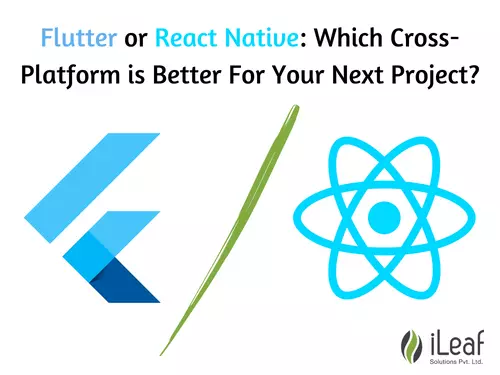Flutter or React Native: Which Cross-Platform is Better For Your Next Project?

Introduction
The Information Technology sector is witnessing a rise in the use of cross-platform solutions for manufacturing native applications. Developers and clients alike are searching for quick, cost-effective, and durable technologies for various applications. When it comes to cross-platform solutions, Flutter and React Native are the preferred choices for many developers. Each platform has its own advantages and disadvantages, which can be evaluated based on usage characteristics and business factors. In this article, we will extensively compare Flutter and React Native, focusing on their essential aspects, to help you make an informed choice for your next mobile application project.
Brief Facts about Flutter and React Native
- Flutter is a portable UI toolkit developed by Google for creating natively-compiled applications for smartphones, the Web, and desktops using a single codebase. It offers rich widgets, which contribute to its appealing look and feel. Flutter has gained popularity steadily and provides excellent documentation and support. Moreover, Flutter offers features that enhance web applications, making it versatile for developing codebases for both the web and smartphones.
- On the other hand, React Native is a framework for building native applications using React. It has been in the market for over five years, gaining stability and attracting numerous prospects and prominent users. React Native has a large and mature community, making it easy for developers to learn and access extensive tutorials. The code created in React Native can be used to develop applications for both the web and mobile phones.
- Flutter was officially released by Google in December 2018 at the Google I/O event, while React Native was launched in March 2015 during the F8 Conference. Flutter is a Google product, whereas React Native is owned by Facebook. Both platforms are open-source and available for free. Flutter uses the Dart programming language, while React Native utilizes JavaScript.
- Since their evolution, both platforms have gained immense popularity. As of December 2019, Flutter had 81,200 stars on Github, and React Native had 83,200 stars. Both platforms support Hot Reloads and deliver excellent native performance. Flutter is generally considered faster than React Native.
Top Applications Developed Using Flutter and React Native
Flutter has been used to develop several popular applications, including the Xianyu app by Alibaba, the Hamilton app for Hamilton Musical, Reflectly, the Topline app by Abbey Road Studios, JD Finance Application, and Google Ads applications.
React Native has been utilized in the development of top applications such as Instagram, Facebook, Facebook Ads, Skype, Tesla, Pinterest, Bloomberg, and WiX.
Understanding the Flutter Platform
Flutter is an open-source platform created by Google that uses the Dart programming language. It is designed as an efficient toolkit for developing software targeting various platforms like desktop, web, and mobile phones. Developers need to learn Dart to work on the Flutter platform. Although Dart may not be as popular as JavaScript, it is an efficient and easy-to-learn language, particularly for developers with a C++ or Java background. Flutter enables the creation of flexible and visually appealing user interfaces with native performance. The platform also benefits from Google's extensive support team, ready to provide assistance when needed.
Fun Stats about Flutter
According to a report by Statista, approximately 39 percent of developers worldwide use Flutter for developing cross-platform mobile applications.
StackOverflow's developers' survey results indicate that 69.8 percent of users in the development community love using Flutter.
Another edition of the report highlights that 7.2 percent of the community prefers Flutter for its tools and libraries.
Understanding the React Native Platform
React Native is an open-source platform that runs on the JavaScript programming language. It is designed to cater to native development using various technologies, particularly for iOS and Android developers and users. React Native combines JavaScript and XML-esque markup, known as JSX, to create applications. Facebook, the giant company, owns React Native and has a dedicated team of efficient engineers continually working on the framework. React Native is a powerful toolkit for cross-platform development, enabling the creation of iOS and Android applications using a single codebase with React. It is important to note that React Native is not for developing mobile web applications but rather a framework for building blocks similar to regular iOS or Android applications using JavaScript and React.
Fun Stats about React Native
According to a report by Statista in 2020, approximately 42 percent of developers use React Native for developing cross-platform applications.
StackOverflow's report indicates that 11.5 percent of developers prefer React Native for its native tools and libraries.
Another report by StackOverflow shows that 58.5 percent of the development community loves React Native.
iLeaf Solutions' Competitive Advantage
We empower developers with multiple competitive advantages through its range of services. We are a leading healthcare application developer in the UK, US, and Canada. We have demonstrated great efficiency in developing applications using both React Native and Flutter for web and mobile platforms.
For example, we successfully created a Flutter-based application called Picterus, which estimates jaundice levels in newborns as part of a semi-government project in the North. Picterus received over 6 million Euros of funding from the European Union's Horizon 2020 Research and Innovation program, highlighting its merit.We have also leveraged the React Native framework in applications like ROOST, which simplifies the smart home experience. ROOST allows users to control home appliances and transform their houses into smart homes. The application utilizes intelligent sensors connected to a broadband connection to provide notifications about water or fire incidents.
Conclusion
In conclusion, let's discuss the pros and cons of Flutter and React Native. React Native gained popularity earlier since its release in 2015, while Flutter entered the market in 2018. The programming languages used differ as React Native relies on JavaScript, while Flutter utilizes Dart. In terms of performance, Flutter is considered more efficient than React Native due to its utilization of the JavaScript Bridge, enabling seamless communication in native applications. The technical architecture of both platforms also varies, with React Native using a JS runtime environment (JavaScript Bridge) to communicate with native APIs, and Flutter employing a hierarchical layered architecture with platform-specific widgets.
The shift from developing native applications to cross-platform applications has brought about significant changes, and the choice of platform should be based on project requirements and the expertise required for application development.
By partnering with us, developers can harness the competitive advantages offered by their services. Whether through Flutter-based applications like Picterus or React Native-based applications like ROOST, iLeaf has proven its capabilities in the healthcare sector and beyond. Choose the platform that aligns with your project requirements and leverage the expertise provided by iLeaf Solutions to create powerful and innovative applications.














